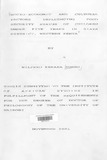| dc.description.abstract | This study investigated the socio-economic and cultural factors
that affect the food security of children under five years in Boro
and Usigu Divisions of Siaya District in Western Kenya. Food
insecurity is a common problem in the area and children under five
are the most vulnerable group that are affected by the problem.
Children always need adequate nutritious food for body maintenance
and growth. Fieldwork for this study was carried out between August
1997 and August 1998.
The overall objective of the study was to investigate how socioeconomic
and cultural factors affect the food security status of
children under five years in the two divisions. The study had five
specific objectives as follows: First, to document the extent to
which the availability of food influenced the food security status
of children under five years. Second, to examine the extent to
which eating habits and beliefs concerning the consumption of
certain foods influence the food security status of children under
five years. Third, to determine the influence of food distribution
systems by various households on the food security status of
children under five years. Fourth, to examine the influence of
income levels of heads of households on the food security status of
children under five years. Fifth, to investigate how decisions made
by powerful individuals in the household, such as husbands,
mothers-in-law and senior wives, influence the food security status
of children under five years,
The methods of data collection used were structured interviews,
participant observation, case studies, focus group discussions, key
informants and documentary sources. The sampling was done using
probability sampling procedures, namely, simple random, cluster and
systematic sampling. The main respondents were women of
reproductive age, that is, those aged between 15 and 49 years, and
who were mothers of children aged under five years. A total of 288
women were interviewed, 144 in each of the two Divisions.
Data were analyzed through both qualitative and quantitative
methods. Data from focus groups, case studies and key informants
were analyzed qualitatively, whereas those from structured
interviews was analyzed quantitatively. The qualitative methods
were descriptions and explanations, while quantitative ones
involved calculations of frequencies and percentages.
The main findings of the study were as follows:
First, most respondents cultivated very small pieces of land which
did not yield enough food crops to last them from one harvesting
season to another. This reduced the level of food availability in
their households. Second, there were a number of foods that were
prohibited to children under five years, notably meat and certain
types of fish such as mud-fish and Nile perch. In addition, certain
types of food were considered to be particularly nutritious to
children. These included traditional vegetables such as the popular
Corchorus oIi torius (mrenda)
are believed to be easily
digestive system.
and Amaranthus hybridus (ododo) which
digested by the children's tender
Third, food sharing between neighbouring households was found to be
a cherished cultural practice That was beneficial to children's
food security since it enabled them to consume the varieties of
foods produced in the neighbourhood. Fourth, lack of stable income
hampered respondents from improving the level of food security in
their households. Finally, children's food security was dependent
on decisions made by powerful individuals in the households such as
mothers, fathers, mothers-in-law and grandparents. This study
recommends that further research needs to be done concerning
traditional foods that are suitable for children under five years
in order to improve their food security. | en |

